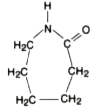Which one of the following molecules can serve as a monomer for an addition polymer?
H2C=CH−C6H5
H2C=CHCN
ClCH=CH2
All of these
The correct Answer is:D
To determine which molecule can serve as a monomer for an addition polymer, we need to identify if the molecule contains a double or triple bond. Addition polymers are formed when monomers with these types of bonds undergo a reaction that opens the bond, allowing them to link together into a long chain.
1. Identify the Structure of Each Molecule:
- Look at the provided options and identify their molecular structures. We need to check if they contain double or triple bonds.
2. Check for Double or Triple Bonds:
- For each molecule, verify if there is a double bond (C=C) or a triple bond (C≡C). These bonds are essential for addition polymerization.
3. Analyze Each Molecule:
- Molecule 1: If it has a double bond, it can undergo addition polymerization.
- Molecule 2: Check for a double bond; if present, it can also serve as a monomer.
- Molecule 3: Again, check for a double bond.
- Molecule 4: Confirm the presence of a double bond.
4. Determine the Repeating Unit:
- For each molecule that has a double bond, illustrate how the double bond can break and how the monomers can link together to form a repeating unit.
5. Conclusion:
- If all the molecules contain double bonds, then all of them can serve as monomers for addition polymers.
Final Answer:
All of the given molecules can serve as monomers for addition polymers because they all contain double bonds.
- Look at the provided options and identify their molecular structures. We need to check if they contain double or triple bonds.
- For each molecule, verify if there is a double bond (C=C) or a triple bond (C≡C). These bonds are essential for addition polymerization.
- Molecule 1: If it has a double bond, it can undergo addition polymerization.
- Molecule 2: Check for a double bond; if present, it can also serve as a monomer.
- Molecule 3: Again, check for a double bond.
- Molecule 4: Confirm the presence of a double bond.
- For each molecule that has a double bond, illustrate how the double bond can break and how the monomers can link together to form a repeating unit.
- If all the molecules contain double bonds, then all of them can serve as monomers for addition polymers.
All of the given molecules can serve as monomers for addition polymers because they all contain double bonds.
Similar Questions
Knowledge Check
Example of addition polymer is
ABuna-SBbakeliteCnylon-6DmalamacAn example of addition polymer is
APVCBBakeliteCCelluloseDNylon-6,6Which of the following polymer can be formed by using the monomer unit?
 ANylon 6, 6BNylon-2-nylon-6CMelamine polymerDNylon-6
ANylon 6, 6BNylon-2-nylon-6CMelamine polymerDNylon-6
The monomer for Teflon polymer is
View SolutionWhich of the following polymers can be made by free radical addition polymersation mechanism?
View SolutionWhich of the following polymers can be made by cationic addition polymersation mechanism?
View SolutionWhich of the following polymers can be made by anionic addition polymerisation mechanism?
View SolutionExamples of addition polymers are
View Solution